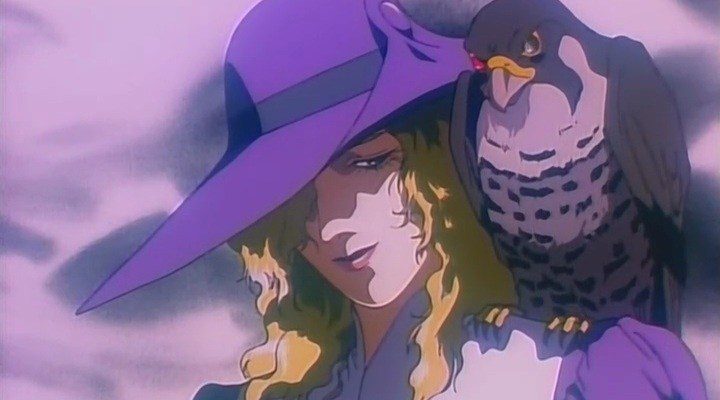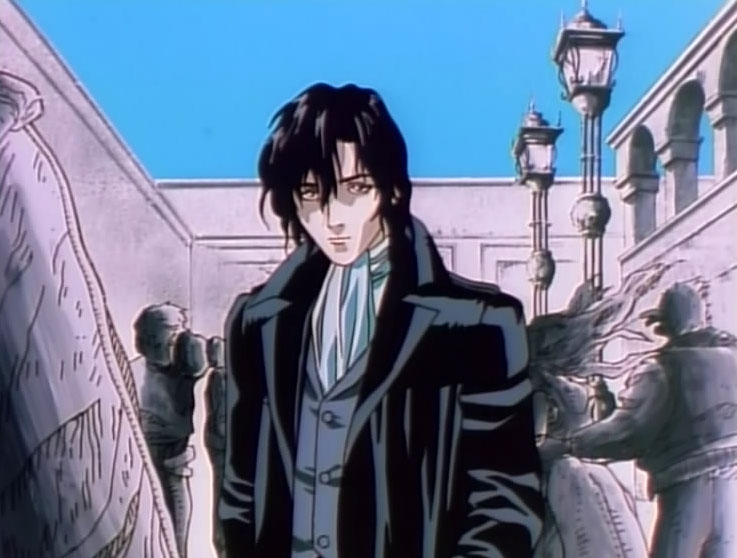| From http://garaitimi.hu/blog/wp-content /uploads/2011/03/darsideblues.jpg |
Director: Yoriyasu Kogawa
Screenplay: Mayori Sekijima
Based on the manga by Hideyuki
Kikuchi
Voice Cast: Akio Ohtsuka as
Kenzou; Hideyuki Hori as Gren; Kotono Mitsuishi as Mai; Kouichi Yamadera as
Enji; Masako Katsuki as Tamaki; Maya Okamoto as Selia; Natsuki Sakan as
Darkside; Nozomu Sasaki as Katari; Shinichiro Miki as Chris; Yasunori Matsumoto
as Tatsuya
Viewed in English Dub
Synopsis: In dystopian Japan, one giant corporation named the Persona
Century Corporation rules the world, their lair high above the planet Earth on
a satellite with its own giant laser. However, in a world where science and
magic have intermingled, a figure who dubs himself Darkside appears on the
street of the same name one night, out of a void in a horse drawn carriage.
Living within a hotel, Darkside only intermingles as a psionic healer, but his
influence on Mai, the youthful leader of the anti Persona group dubbed Messiah,
is going to have an immense effect on her and those she stands side-by-side
with.
Opening scene, fearing this would
turn into something gristly when a woman is stripped to the waist about to be
tortured by another, more so as Darkside
Blues' original author (both the manga and short story) also wrote the
source material for Wicked City (1987).
Instead, whilst it's still nasty, the villainess, as she monologues with a pet
bird on her shoulder, plans to torture what is revealed to be a female rebel
against the Persona Century Corporation by slowly turning her into gold whilst alive through a science-meets-alchemy
pincher machine that sticks in both sides around her stomach. This is fair
warning, and apt introduction, to the curious world of Darkside Blues, a world where futuristic sci-fi is intertwined with
mysticism, robots against magic welding mutant assassins.
It stresses that, in terms of
anime of a certain generation, novelist and manga author Hideyuki Kikuchi has had such a profound influence. I've mentioned
one of his more infamous works, at least with the anime adaptation with its
transgressive content, but he also (with the vital contributions of legendary
illustrator Yoshitaka Amano) created Vampire
Hunter D, a series which has had a lasting legacy. Alongside other titles I
will inevitably get to, as he has had a lot of material adapted into anime, his
style of crossing various genres is very idiosyncratic to any project based on
his work, allowing animated adaptations a lot of leeway to work with.
 |
| From https://www.film-rezensionen.de/wp-content/uploads/2017/ 02/Darkside-Blues-Frontpage-720x400.jpg |
Darkside Blues is such an example but with the warning that, sadly, this is all we got in terms of a proper adaptation of Kikuchi's source material, throwing the viewer in media res in the midst of the world and not having a resolution that resolves the dystopian world it begins with. It is not a film which ends with good triumphing over evil, but a character, not even the protagonists, deciding to join the fight against the big bad. Like a lot of anime, it's a film which teases you with such an enticing world only for it to be a mere slither of the source material. So many anime have been promotional material for manga, sometimes (a lot of times) without the original novels or manga even being available in the West. When it is good, it's always tragic to witness.
What you do get with Darkside Blues thankfully repays the
patient viewer with pure atmosphere. The hybrid of genres which is common in
anime but adaptations of Kikuchi's work
are distinct. This particular one is even different by itself because it is laced
in a slow, deliberate mood and emphasises characters, surprising for a film
merely eighty minutes long. Immediately made clear is also the sharp contrast
between its dystopian story against gothic production design, a fascinating
melding which works beautifully as it does in the 2000 adaption Vampire Hunter D: Bloodlust, only here it's
not the post-apocalypse but pure urban sprawl as a setting within one of the
last environments the villains haven't bought. All of this story is whilst, in
spite of having some actions scenes and gore, being a deliberately moody work,
intercutting moments of a spider in a room with red lace or silent
contemplation against those aforementioned action scenes. That it's a mere
snapshot of a larger world is both despairing but also adds to the power to the
film. In anime, for whatever reason, you can have these titles (especially from
the nineties) which never had proper endings but still developed fans, all of
us gnawing at our knuckles as to why there was never a sequel, but loving the
final result nonetheless. It immediately won me over, when the opening credits
are finally shown, but scoring the first shown down between heroes and villains
to an honest-to-God American blues song.
It's rewarding as well as, for
what little time you spend in this world, its characters are unconventional for
anime. Darkside, despite being your typical dark and handsome stranger with
unnatural powers from the void he came from, is intentionally passive. He feels
like he's from the same template as D, Kikuchi's
most famous creation in his quiet manner and elegance, but taken to a further
extreme that he deliberately inert in his involvements. He will lash back, but
always deflecting bullets and magic missiles fired at himself, instead
deliberately stays off to the sides, intervening to heal other characters and
stop the villains from harming people. He spends most of his time throughout
the film, in the most intriguing aspect of the world building, within a motel
ran by an old woman where characters are pulled by a magic force to the room
they want to go, where among his potential abilities (including maybe even
extending the life further of the old woman's pet cat) is counselling of
clients' memories and dreams, healing them and (even outside the hotel) using this
ability to push the protagonists to major decisions but pulling them into their
traumas and memories. Literally he's a counsellor to the real main characters,
who just happens to be a quietly spoken man capable of horrifying dark void
abilities if anyone was insane to push him. Even individuals specifically sent
in by the Persona Century Corporation to deal with him that have their own
special abilities, able to turn entire crowds of bystanders into stone which
break to pieces (and presumably die if not already) in the combat soon after, find
themselves against someone very conventional as protagonists within this type
of nineties adult anime. In another twist, although its sadly lost when it
comes to the English dub, is that a female voice actress named Natsuki Sakan voices Darkside rather
than a man, which adds a unique dynamic for viewers.
 |
| From https://i.ytimg.com/vi/nZh2z2xZsBY/hqdefault.jpg |
Instead it's the female characters who are the most interesting. That's not to say there's some curious characterisations for the better, most if not all the characters even for the few minutes they have curious and unique, such as that enforcer sent against Darkside having a heroic moment rescuing a woman from a group of men which complicates things, or the mutant magic welding assassin who literally looks like an older, chubby Japanese salaryman. But in terms of complex characters, Mai as the leader of the Messiah group, who holds a vaguely told back-story of trauma, is interesting as the strong willed but thoughtful leader, she and her motley crew finding themselves further against Persona especially when a militarised rebel escapes into their midst. Another character, a nurse named Selia, is even more interesting and is the figure who gets the real ending of the adaptation; with even greater trauma in his life due to her family being victims of the giant space laser Persona own, she keeps her father's rifle as a traumatic memento, her progression from being a mere friend to Mai's cause onwards where the resolution of the film comes from. Thankfully this means Darkside Blues, unlike other anime, actually has an ending but it's fascinating that this ending is a miniscule character drama set within a huge world left untouched, as if a fragment of what could've gone obviously for longer. Again, the slither of virtues is rewarding even if I wished this had lasted onwards to more.
Production wise, its gorgeous. This
era of anime gladly lavished even the most lurid of stories with a distinct
production design, and generally have a sense of flair both in background and
character designs that stood out, details that could easily be ignored especially
in some of the worst, less cared for OVAs from this same era. All that would've
been as painstaking as everything else to include, such as having the lead male villain wear a
golden mask in public, deliberately designed to look robotic and faceless for ominous.
It's a style that could've easily turned into clichéd Goth aesthetic, a lot of
black and moody characterisation, were it not for the curious inclusion of
genres like science fiction. Arguably, when it comes to adapting Hideyuki Kikuchi's work, there's no fear
in the slightest of it ever become clichéd, even the more cartoonish 1985 anime
of Vampire Hunter D being distinct. So
much so that, yes, that it has no large scale resolution and never had any animated
sequels or remakes is disappointing. [And the likelihood of finding the ADV Manga translation of the manga
adaptation is only through pure luck and an excavation through countless second
hand dealer boxes and warehouses of stock for long dissolved companies.] So one
has to gnash their teeth, like I have, when the material is as compelling as
this.
 |
| From https://www.animeclick.it/images/ Anime_big/DarksideBlues/DarksideBlues33.jpg |
No comments:
Post a Comment